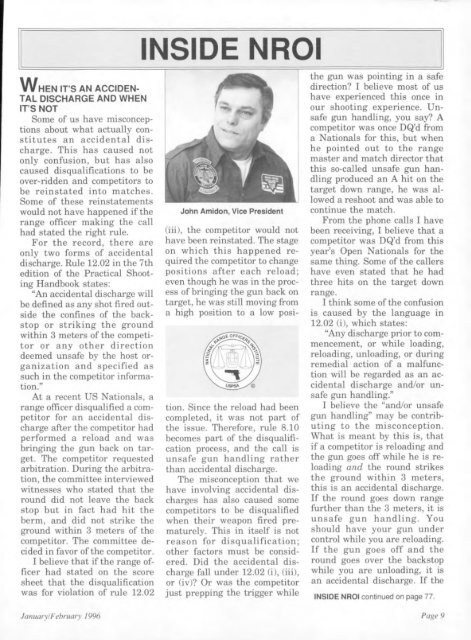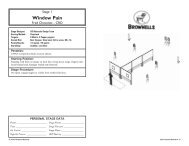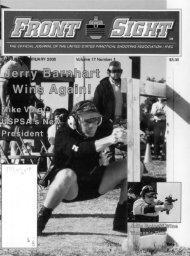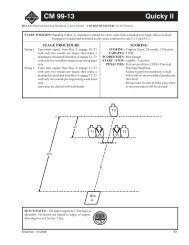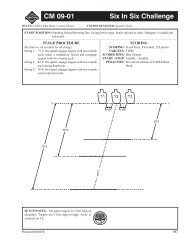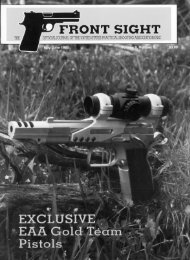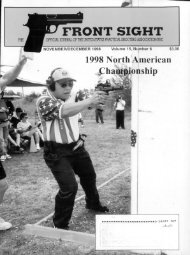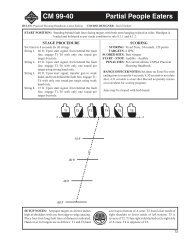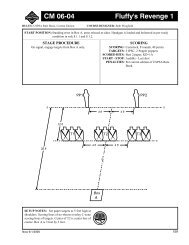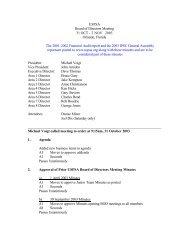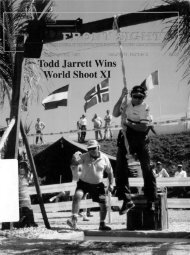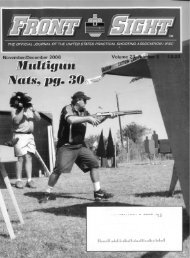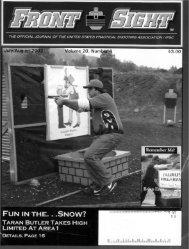Jan/Feb - uspsa
Jan/Feb - uspsa
Jan/Feb - uspsa
Create successful ePaper yourself
Turn your PDF publications into a flip-book with our unique Google optimized e-Paper software.
WHEN IT'S AN ACCIDEN-TAL DISCHARGE AND WHENIT'S NOTSome of us have misconceptionsabout what actually constitutesan accidental discharge.This has caused notonly confusion, but has alsocaused disqualifications to beover-ridden and competitors tobe reinstated into matches.Some of these reinstatementswould not have happened if therange officer making the callhad stated the right rule.For the record, there areonly two forms of accidentaldischarge. Rule 12.02 in the 7thedition of the Practical ShootingHandbook states:"An accidental discharge willbe defined as any shot fired outsidethe confines of the backstopor striking the groundwithin 3 meters of the competitoror any other directiondeemed unsafe by the host organizationand specified assuch in the competitor information."At a recent US Nationals, arange officer disqualified a competitorfor an accidental dischargeafter the competitor hadperformed a reload and wasbringing the gun back on target.The competitor requestedarbitration. During the arbitration,the committee interviewedwitnesses who stated that theround did not leave the backstop but in fact had hit theberm, and did not strike theground within 3 meters of thecompetitor. The committee decidedin favor of the competitor.I believe that if the range officerhad stated on the scoresheet that the disqualificationwas for violation of rule 12.02INSIDE NROIJohn Amidon, Vice President(iii), the competitor would nothave been reinstated. The stageon which this happened requiredthe competitor to changepositions after each reload;even though he was in the processof bringing the gun back ontarget, he was still moving froma high position to a low posi-tion. Since the reload had beencompleted, it was not part ofthe issue. Therefore, rule 8.10becomes part of the disqualificationprocess, and the call isunsafe gun handling ratherthan accidental discharge.The misconception that wehave involving accidental dischargeshas also caused somecompetitors to be disqualifiedwhen their weapon fired prematurely.This in itself is notreason for disqualification;other factors must be considered.Did the accidental dischargefall under 12.02 (i), (iii),or (iv)? Or was the competitorjust prepping the trigger whilethe gun was pointing in a safedirection? I believe most of ushave experienced this once inour shooting experience. Unsafegun handling, you say? Acompetitor was once DQ'd froma Nationals for this, but whenhe pointed out to the rangemaster and match director thatthis so-called unsafe gun handlingproduced an A hit on thetarget down range, he was alloweda reshoot and was able tocontinue the match.From the phone calls I havebeen receiving, I believe that acompetitor was DQ'd from thisyear's Open Nationals for thesame thing. Some of the callershave even stated that he hadthree hits on the target downrange.I think some of the confusionis caused by the language in12.02 (i), which states:"Any discharge prior to commencement,or while loading,reloading, unloading, or duringremedial action of a malfunctionwill be regarded as art accidentaldischarge and/or unsafegun handling."I believe the "and/or unsafegun handling" may be contributingto the misconception.What is meant by this is, thatif a competitor is reloading andthe gun goes off while he is reloadingand the round strikesthe ground within 3 meters,this is an accidental discharge.If the round goes down rangefurther than the 3 meters, it isunsafe gun handling. Youshould have your gun undercontrol while you are reloading.If the gun goes off and theround goes over the backstopwhile you are unloading, it isan accidental discharge. If theINSIDE NROI continued on page 77.<strong>Jan</strong>uaryl<strong>Feb</strong>ruar_v 1996 Page 9


